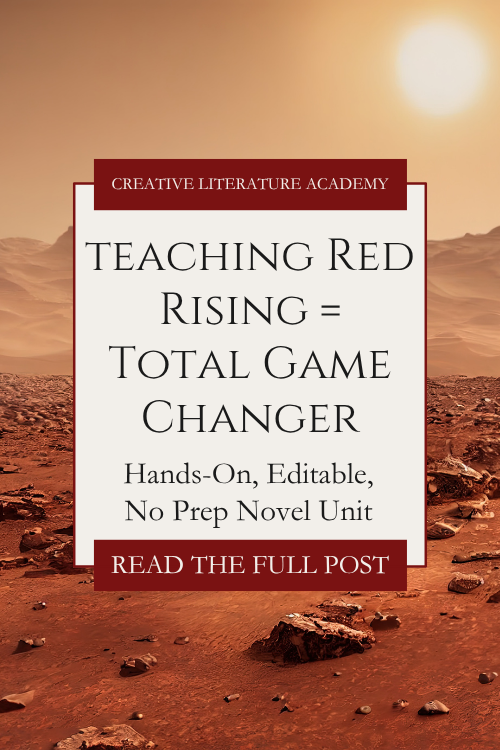From Rebellion to Relevance: Using Red Rising to Spark Real-World Conversations
I taught Red Rising by Pierce Brown to second semester seniors who were not taking AP English during the pandemic–overall, these seniors are my favorite group to teach, but they are infamously unmotivated and it was a wild time… I had spent the first half of the year gaining their loyalty, but by second semester, we all just wanted to have fun. Red Rising was perfect for this!
For all the reasons I chose to teach Red Rising, check out this blog post.
To be honest, the primary reason I chose to teach Red Rising was because I wanted to force someone to discuss it with me, but it ended up being so transformative for my classroom. I had multiple students speed read through it and go on to the following books in the series before the unit was even over. I had students barging into my classroom right after the bell yelling about what they’d read the night before (and these were students who weren’t reading anything at all first semester). I had dyslexic students who had accommodations to never have to read in front of the class volunteer to read their entire creative projects aloud. I had parents thanking me for getting their students back into reading. It was mind blowing.
I think one of the best parts of the book and unit is that it’s a seriously engaging story that deeply connects to our human experience. It’s set on Mars, it’s science fiction, it’s genetically modified humans, it’s war games, it’s a color-coded caste system, but it’s also so human. The questions get to the heart of things we all care about. The world building is immaculate and behind the world Brown builds is a story that is all about inequality, power, surveillance, education, rebellion, grief, love, friendship, identity, and the systems we are born into without our consent.
Essentially, it’s a novel about all the things teens love to talk about couched in a highly engaging story. It’s amazing.
This Book Was Made for Interdisciplinary Teaching
Red Rising is a gold mine for weaving in cross-curricular conversations. The connections come up naturally—no awkward segues needed. The book requires that you think critically about a wide variety of topics and sparks curiosity in every student I’ve come across. We regularly ended up researching random questions, having conversations I hadn’t anticipated, and learning so much about each other and ourselves.
We ended up making connections to:
History/Government: propaganda, revolutions, and social control
Science: biology, genetic engineering, terraforming
Psychology: identity, trauma, and adaptation
Ethics and civics: protest, power, loyalty vs. morality
If you’ve ever wanted to sneak in a mini research component or tap into something your science and history teacher friends are doing, Red Rising gives you a super easy entry point. And, bonus, I’ve included projects and discussions that link to all of these topics in my full novel study unit.
Real Discussions, Real Stakes
What I loved most about teaching this novel wasn’t just the enthusiasm. It was the level of thought. The questions students asked weren’t surface-level. They were working through ideas about justice, systemic oppression, and the personal cost of change.
I’ve never had a novel prompt such consistent, passionate, and thoughtful reactions. My students weren’t just talking about who betrayed who (though there’s plenty of that too); they were genuinely unpacking the ethics of revolution, debating whether power always corrupts, questioning who we become when systems are built to keep us small. It was so easy to just scan the news, bring in a story and relate it to what was going on in the book.
Even students who usually fly under the radar were suddenly raising their hands—not for points, not for praise, but because they needed to weigh in. They had thoughts. They had theories. They wanted to push back on each other and on the text.
I promise this is all real. It may sound too good to be true, but it really is an amazing book to teach.
You Don’t Have to Build the Unit From Scratch
I put together my full Red Rising unit to support all of this: the interdisciplinary connections, the real-world questions, the creative and critical thinking. It’s designed to make your life easier while giving students something genuinely worth engaging with.
Inside the unit, you’ll find:
Daily plans with close reading, writing, and discussion prompts
Creative projects (including fan fiction and group work)
A low-stakes, high-interest pacing guide that works for both traditional and block schedules
Discussion routines and rituals that build classroom community
It’s classroom-ready, flexible, and easy to adapt to your own style. If you’re ready to teach a novel your students won’t just tolerate but rave about, I’ve got everything you need.
👉 Check out the full unit here: Red Rising Dystopian Novel Study
Let me know what you think or if you have any questions!
